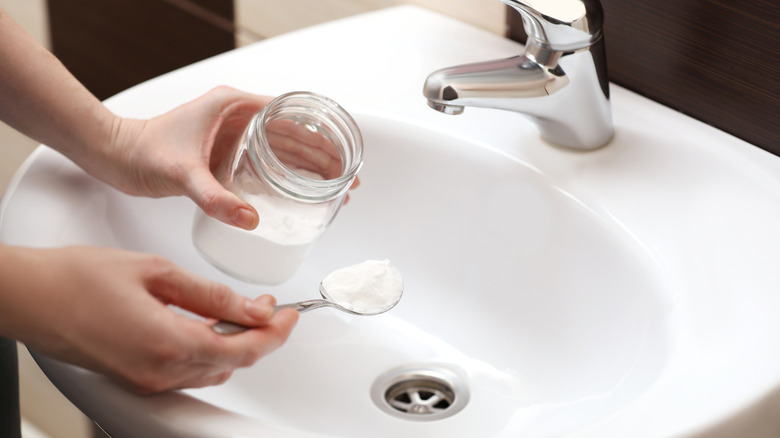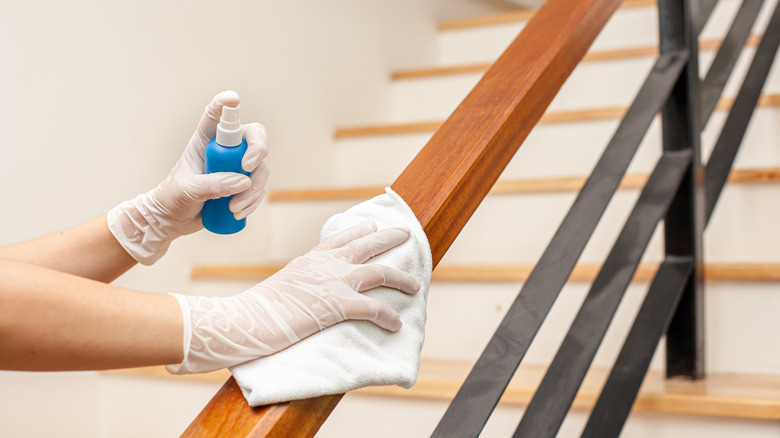The Major Hidden Downside Of Cleaning With Baking Soda
Baking soda is one of the most versatile compounds in anyone's home. From laundry stains to trash can odors and bathtub grime, baking soda scrubs away our stinkiest and most stuck-on sins. Plus, its non-toxic nature is safe enough to use on child and pet products and even many toothpastes. But despite its wonderous cleaning abilities, baking soda does have one serious downside — it doesn't disinfect. If you're scrubbing almost everything in your home with baking soda, you may want to put the box down and rethink your cleaning habits.
Don't get us wrong; baking soda is an essential compound to have in any cleaning arsenal. However, depending on what you're cleaning, baking soda may not always deliver great results. That's because while baking soda might reduce odors and scrub away muck, it isn't very effective at actually killing germs and bacteria. In areas where harmful bacteria thrive, failing to sanitize surfaces can leave you and your family at risk of catching serious illnesses. Here's why baking soda doesn't disinfect and what you can use instead to ensure a safe and germ-free clean.
Baking soda is not a disinfectant
Baking soda cleaning hacks might offer a gentle and effective solution for visible stains, dirt, and grime, but they won't make surfaces more sanitary. While baking soda does have some antibacterial properties, it's simply not enough to give your home a lasting clean. While baking soda can kill some forms of bacteria and fungi, it doesn't do a very good job of eliminating most other germs, including illness-causing bacteria like E. Coli, Salmonella, and cold and flu viruses.
Baking soda doesn't kill germs, but it can weaken them and make other antibacterial solutions more effective. It can act as a gentle abrasive, scrubbing away grime on countertops and dishes so that your disinfectant or dish soap can work more effectively. In other words, baking soda won't do much to kill bacteria and viruses on its own, but it can be a good first step in your cleaning and disinfecting routine.
Where and where not to clean with baking soda
In general, cleaning with baking soda is not a great idea anywhere germs are a serious concern. Sanitization is especially important in bathrooms and kitchens, where the risk for bacterial spread is high. Some of the more harmful bacteria including E. Coli, Staphylococcus, and Salmonella thrive on bathroom and kitchen surfaces, sinks, sponges, cutting boards, and more. Neglecting to kill these bacteria in either room can lead to accidental food contamination and serious illness. For bathroom and kitchen surfaces, especially food-prep areas, it's best to reach for Lysol or a solution containing bleach or alcohol. Remember to always use extreme caution when cleaning with various chemicals, and never mix bleach with vinegar, alcohol, ammonia, or Lysol disinfectants.
Suppose you prefer to keep your cleaning routine as all-natural as possible. In that case, you can use other disinfecting ingredients after baking soda or combine them with baking soda to kill more germs. Essential oils including tea tree, lemongrass, orange, peppermint, and eucalyptus oil are very effective at fighting bacteria and fungi. Vinegar, which is highly acidic, can also reduce bacterial numbers. For the ultimate cleaning power, however, stick with a store-bought disinfectant.


